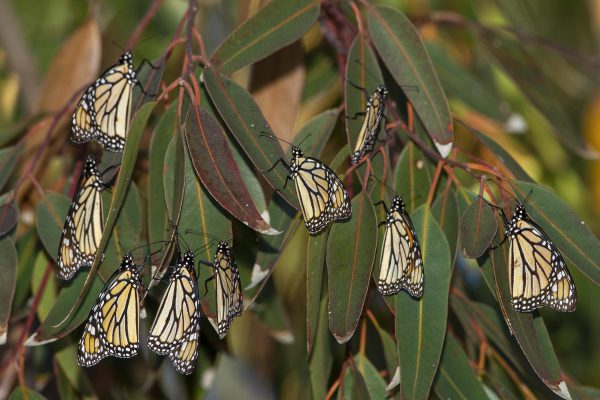
So far, more than 200,000 monarch butterflies have made it to California for the winter, a dramatic upsurge from the 2,000 that were counted last year, according to the most recent tally for the 25th annual Thanksgiving western monarch butterfly count.
And they’re still counting.
“We anticipate that number going up once we receive all the data,” said Emma Pelton, senior conservation biologist for the Xerces Society for Invertebrate Conservation, coordinator of the statewide count. “It’s pretty exciting.”
It’s exciting because last year’s low number practically rang the death toll for the iconic winged beauties. In contrast, two million monarchs were counted here in the 1980s and hundreds of thousands just a few years ago, Pelton said.
“This is the largest increase in a single year in terms of percentages,” she said. “Insect numbers bounce around and this is a bounce up. But we can’t really say from one year’s data that it means they’re coming back or it means they’re recovering.”
Orange County counts also banked an increase during the Thanksgiving run this year from Nov. 13 to Dec. 5. A total of 254 monarchs were found at nine of the 13 coastal sites monitored, said Bob Allen, a Santiago Canyon College adjunct professor of Biology and Orange County regional coordinator for the annual counts.
The majority of butterflies, 147 in one cluster, were found dangling in the cold morning air from the leaves of a eucalyptus tree near the amphitheater at Huntington Central Park. Monarchs haven’t been seen overwintering there for years, Allen said. The second largest cluster, 38, was found at Gibbs Park, also in Huntington Beach.
“It’s a far cry from just 25 years ago when almost 14,000 were counted in Orange County,” said Ron Vanderhoff, Roger’s Gardens general manager and count team member. “But it is encouraging.”
Last year, Allen’s team found a single overwintering monarch roosting along Orange County’s coast. There were only three in 2019 and a slim 56 and 68 in 2018 and 2017, respectively. “It’s encouraging to have more than one,” Allen commented about this year’s uptick.
“I think what’s happening now is that monarchs are getting here earlier in October, then heading north along the coastline and staying other places that have lots of monarchs, like Ellwood Grove in Santa Barbara and Pismo Beach,” he speculated. An early survey of nearly 300 monarchs at a private residence in San Clemente was taken by Vanderhoff on Oct. 24. They were nowhere to be seen during the official count.
There’s more speculation as to why this year’s Thanksgiving count is higher.
“Insect populations can do really funky things, especially when the populations get small,” said Pelton. “We might be seeing a combined chaos of the system.”
With only a maximum six-month lifespan, female monarchs can lay 300 eggs. They usually don’t, Pelton said.
“But maybe because the numbers were so low last year, they had the ability to bounce back by laying more eggs. But we didn’t think they could bounce back this much this year,” she said.
Statewide counts for both 2019 and 2020 were considered record lows with only 30,000 monarchs recorded in both years, causing grave concern. After this tally, scientists said monarchs reached the lowest point prior to migration collapse, which means there wouldn’t be enough monarchs to migrate, reported Xerces.
Other combined chaos factors for the big bounce this year could be that monarch predators stopped focusing on a marginal food source, disease rates were lower due to a smaller population and there were more offspring, she conjectured. “Because they have so many offspring, having a really good start to the year just magnifies over the season,” she said. “So we could see a big increase this year because of one really good season.”
Another take on higher numbers is that the average person got on board, planting wild, native milkweeds in home gardens throughout the state. In addition to statewide efforts to preserve natural habitats and reduced use of insecticides and herbicides, more homegrown native plants support caterpillars with food and produce flowers that provide nectar to fuel adult pollinators and butterflies.
This year, Tree of Life Nursery in San Juan Capistrano, the largest native plant nursery in the state, partnered with Roger’s Gardens in Newport Beach, which has stopped selling tropical milkweed, invasive plant species and neonicotinoid insecticides, reported that customers took home 16,000 native milkweeds.
Roger’s Gardens even offered a free milkweed exchange program, Vanderhoff said. When customers brought in an uprooted tropical milkweed, they were given a free native milkweed in exchange, one per household. Considering sales at other local nurseries, Vanderhoff estimates that 20,000 new native milkweed plants have taken root in and around suburban Orange County.
In addition to planting native milkweeds, providing native flowering plants for nectar is crucial to pollinator insect survival, Allen said.
Some of these include specific ecosystem plants native to Orange County, such as asters, goldenrod, golden bush, buckwheat and bush sunflower.
“The effects of wildfires, habitat loss, pathogens, climate change and a host of other factors might be somewhat mitigated by simply planting native butterfly plants in home landscapes,” surmised Vanderhoff.
On the downside for the upsurge is the prevalence of tropical milkweed, a danger to monarchs, explains Pelton. The tropical variety, heralding from South America and other more southern countries, doesn’t go dormant in the winter. Scientists conjecture there’s more monarch butterflies now because they’re eating and breeding year-round on tropical milkweed. The danger to monarchs is that tropical variants of the plants host a poisonous deterrent to insects. As for the tropical milkweed, Allen suggests carefully pulling out the plant and trashing it.
To qualify as overwintering, the monarchs must be counted as they hang in trees overnight before the sun warms up their wings for flying. Official counts include only wild western monarchs, not monarchs raised in kits at home on non-native, tropical milkweed, said Allen, who’s been tagging monarchs for about 50 years.
Western monarchs overwinter here from colder northwest and Rocky Mountain climates and then return in the spring. Final figures for the annual Thanksgiving monarch count are expected to be released in mid-January. Official counts can be followed at westernmonarchcount.org.




